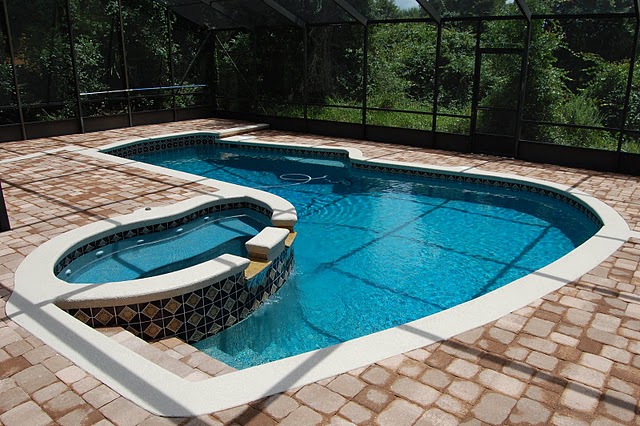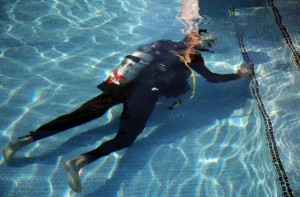Pool Leak Detection
 Your pool will naturally lose some water to evaporation, some to splash-out and some to backwash wastewater. You may also gain water from rainfall. A rule of thumb is that if you’re routinely adding more than two inches of water to your pool per week, you may have a leak. It is worth spending some time and money to repair.
Your pool will naturally lose some water to evaporation, some to splash-out and some to backwash wastewater. You may also gain water from rainfall. A rule of thumb is that if you’re routinely adding more than two inches of water to your pool per week, you may have a leak. It is worth spending some time and money to repair.
Pools are meant to be watertight but sealants will deteriorate while other parts of your pool shift and settle or just plain wear out. Pools can leak through any of the fittings or accessories, plumbing, or even right through the shell. It is important to repair leaks, not only to save water, heat, and chemicals, but also to prevent undermining pool structural components and washing away fill dirt.
Most of all phone calls we get from worried pool owners about a leak turn out to be inexpensive to repair. So relax, if you can’t take care of the problem yourself a professional will be equipped to do so for you. If you suspect a leak, review the following things before calling for service:
1Is the pool leaking only with the equipment on?This may indicate a pressure-side return leak. With the filter pump on, the plumbing on the pressure side is under pressure. This can open up small drips into spraying gushers. Check the waste or backwash line for water consistently running. One inch of your pool water can equal 500 gallons. 2Is the pool leaking only with the equipment off?
This usually indicates a suction-side leak. With the filter pump on, the plumbing on the suction side is under vacuum. Air can be drawn in through otherwise leaking voids. You may notice air in the pump basket (if you have a clear lid), air bubbling out of the return lines, or air repeatedly built up inside the filter tank. Use tape or a pencil to mark water levels. Is the pump basket lid on tight with a good, lubed o-ring? 3Does the pool leak all the time?
This does not rule out leaks in the plumbing, but turns a suspicious eye on the shell of the pool, looking for cracks in the plaster or tears in the vinyl. Look closely at the tile line and look real closely inside of the skimmer(s). The most common leak we fix is a separation between the plastic skimmer and the concrete pool. This is easily fixed with some pool putty. If you see something that looks like a crack, drop some of your pH indicator test reagent near it with your pump shut off and water still. See if the dye is sucked into the crack. Under water lights can and do leak as well. Especially the conduit that runs from the light niche to the junction box. Filling the opening of the conduit in the back of the light niche with putty, silicone, or caulk is a way to fix this problem. 4Are there leaks at the equipment pad?
Look closely at the filter, pump, heater, and valves. Check the ground for moisture. Turn the pump on and off looking closely for spraying water when the pump is turned off. 5Does the water seem to stabilize at any particular level?
You may be able to close the skimmer valve and allow the water level to drop below the skimmer. If it keeps going, we can rule out the skimmer (although there can always be more than one leak). The underwater light is a common leak source. If the water stabilizes, dye test around this level very carefully. Look for small debris which may have been sucked into the crack or void. This is a good indication of a leak. 6Are there any wet areas around the pool?
Take a walk around the pool’s edge and between the pool and the equipment pad. Check for wet soil and eroded areas. 7Is your pool equipped with a vinyl liner?
If so, there are special considerations. Look for sinkholes where sand under the liner may have washed away. Look for tears or separations around all fittings: skimmer, returns, cleaner line, etc. Pay close attention to steps and corners, where the liner may be stretched more than normal. If an animal had the misfortune to fall into your pool you may notice claw marks (tears) just below the water line. Spending time under water with a mask may be required to find a small leak in the liner. When liners become old they may have many pinhole leaks. There can always be more than one leak. 8Unsure of your evaporation rate?
Place a bucket of water beside the pool and mark both the water in the bucket and the pool water level. Wait 24 hours then check the loss of both. If the pool loses more water than the bucket, then you have a leak.
 Prices for leak detection and repair will vary widely. Of course, charges will be lowered with your help of uncovering the facts (see above) needed to determine the leaks location. Average charges range from $200 or more depending on the extent of your leak. Higher prices will be realized for below ground work; however, many leaks are fixed within one hour. Many pools leak in more than one area so monitoring is important after any repair is made. There may be additional charges for cutting and replacing concrete and for SCUBA (under-water) work.
Prices for leak detection and repair will vary widely. Of course, charges will be lowered with your help of uncovering the facts (see above) needed to determine the leaks location. Average charges range from $200 or more depending on the extent of your leak. Higher prices will be realized for below ground work; however, many leaks are fixed within one hour. Many pools leak in more than one area so monitoring is important after any repair is made. There may be additional charges for cutting and replacing concrete and for SCUBA (under-water) work.




